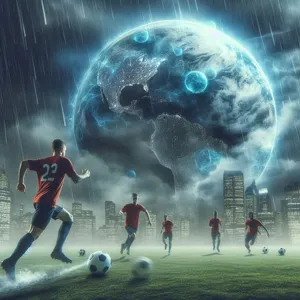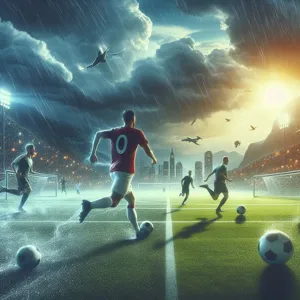Soccer, often hailed as the beautiful game, isn’t just about skillful players and strategic plays; it’s also significantly influenced by the environment in which it is played.
From sweltering heat to torrential rain, the elements can dramatically affect performance on the field. Imagine a sun-soaked afternoon where players struggle with hydration and fatigue, or a gusty, chilly evening that alters the trajectory of a perfectly aimed shot. Understanding how weather conditions impact everything from ball control and player stamina to game strategy and injury risk is crucial for athletes, coaches, and fans alike. In this blog post, we will explore the intricate relationship between weather and soccer performance, delving into how different conditions can shape the game and what players can do to adapt and thrive, no matter what Mother Nature throws their way.
1. Introduction: The Connection Between Weather and Soccer Performance

Soccer, often referred to as the beautiful game, is played on fields across the globe, under a vast array of weather conditions. From the sweltering heat of summer afternoons to the biting chill of winter evenings, the elements can significantly influence how a game unfolds and how players perform. Understanding the connection between weather and soccer performance is crucial for athletes, coaches, and fans alike, as it can dictate everything from player stamina and strategy to the ball’s behavior on the pitch.
Temperature plays a pivotal role in the dynamics of a match. When the mercury rises, for instance, players may struggle with dehydration and fatigue, leading to decreased performance and increased risk of injury. Conversely, in cold weather, muscles can become stiff, and players might find it challenging to maintain agility and speed. Additionally, conditions like rain and wind can transform the game entirely; a slick field can lead to unpredictable ball movement, while strong winds can affect passing accuracy and shot precision.
Moreover, the psychological impact of weather cannot be overlooked. Players may feel more energized and motivated in favorable conditions, while adverse weather can create a sense of frustration or anxiety. The mental fortitude required to adapt to changing elements can make all the difference in high-stakes matches.
As we delve deeper into this topic, we will explore how different weather conditions affect player performance, game strategy, and even fan engagement. By examining these elements, we can better appreciate the intricate relationship between weather and soccer, illuminating how nature shapes the beautiful game we all love.
2. Understanding the Elements: Key Weather Factors Affecting Play
When it comes to soccer, the elements play a pivotal role in determining not just the quality of play but also the outcome of matches. Understanding these key weather factors can provide players and coaches with insights that may influence game strategy and performance.
**Temperature** is perhaps the most immediate weather condition that affects players on the field. On a sweltering day, high temperatures can lead to fatigue and dehydration, affecting players’ stamina and decision-making abilities. Coaches may need to adjust tactics to account for the slower pace and reduced energy levels, perhaps focusing on shorter passing plays that conserve energy. Conversely, in colder climates, while some players thrive in the chill, others may struggle to maintain their dexterity, making them more susceptible to injuries.
**Wind** is another critical factor that can drastically alter the dynamics of a match. Strong gusts can influence the trajectory of the ball, making long passes and shots more unpredictable. Teams may need to adapt their strategies, opting for shorter, more controlled plays when the wind is at its peak. For goalkeepers, wind can be a double-edged sword—while it might help in pushing the ball off course, it can also complicate routine saves and clearances.
**Rain** introduces its own set of challenges, turning the pitch into a slick surface that demands a different approach. Players need to adjust their footing, as sudden changes in traction can lead to slips and falls. Wet conditions can also affect the ball’s behavior, causing it to skid or slow down unexpectedly. Teams may need to focus on maintaining possession and making quick, precise passes to navigate through the muddy terrain effectively.
Lastly, **humidity** can significantly impact player performance. High humidity levels can exacerbate the effects of heat, making it feel much hotter than it actually is. This can lead to increased perspiration and a higher risk of cramps and heat-related illnesses. Teams might need to implement more frequent hydration breaks and consider rotating players more often to maintain peak performance levels.
By understanding these elements—temperature, wind, rain, and humidity—coaches and players can better prepare for the challenges that weather presents, tailoring their strategies to optimize performance no matter the conditions.
3. Temperature: How Heat and Cold Influence Player Performance

Temperature plays a crucial role in shaping soccer performance, impacting everything from players’ physical abilities to their mental sharpness on the field. Extreme heat can be particularly taxing, leading to fatigue, dehydration, and heat exhaustion. When temperatures soar, players may find themselves struggling to maintain their usual speed and agility. The body’s natural response to heat includes sweating and increased heart rates, which can lead to a decline in overall performance. Coaches often emphasize hydration and cooling strategies, such as water breaks and shaded sidelines, to help players cope with soaring temperatures.
Conversely, cold weather presents its own set of challenges. Low temperatures can stiffen muscles and joints, making injuries more likely and affecting players’ flexibility and reaction times. In frigid conditions, maintaining optimal body temperature becomes essential; players often layer their gear to combat the chill. The psychological aspect of cold weather shouldn’t be overlooked either. Players may experience decreased motivation or a sluggish mindset, making it more difficult to stay focused during the match.
Both extremes of temperature demand a strategic approach from coaches and players alike. Understanding how heat and cold can influence player performance allows teams to adapt their training and game plans accordingly. Whether it’s implementing heat acclimatization strategies in the summer or ensuring proper warm-up routines during winter months, recognizing the impact of temperature is essential for maximizing player performance and maintaining team morale on the pitch.
4. Rain and Wet Conditions: Impact on the Field and Player Movement
Rain and wet conditions can dramatically alter the dynamics of a soccer match, impacting everything from the playing surface to player performance. When the heavens open, the natural grass or turf transforms into a slick, unpredictable terrain that demands a different set of skills and strategies. The field becomes a canvas of puddles and mud, which can lead to both exciting plays and unforeseen challenges.
One of the most immediate effects of rain is the reduced traction on the field. Players often find themselves slipping and sliding, making it difficult to maintain control over their movements. Quick cuts and sudden sprints that might be executed flawlessly on a dry pitch can quickly turn into a game of balance, as players must adjust their footwork to avoid face-planting into the mud. This can lead to a more cautious approach to tackling, as players become wary of the added risk of injury from falls.
Ball control is also notably affected in wet conditions. A soaked ball can become heavier, causing passes to travel differently and making it harder for players to predict its movement. Dribbling can turn into a test of skill and finesse as the ball may skip or slide unpredictably on the wet surface. Players often need to recalibrate their touch and timing, adapting to the slower response of the ball on the slick grass.
Moreover, the weather affects not just the physical aspects of play but the psychological ones too. Players may find themselves second-guessing their decisions, leading to hesitation that can disrupt team cohesion. On the flip side, some players thrive in the rain, relishing the challenge that comes with slippery conditions. These individuals often exhibit a level of creativity and improvisation that can turn a downpour into an advantage, using the unpredictable nature of the field to their benefit.
Coaches must also adapt their strategies in the rain, emphasizing ball retention and short passing to mitigate the risks of a slippery pitch. Tactical adjustments, like prioritizing possession over a long ball strategy, can make all the difference when the rain starts to fall.
In conclusion, rain and wet conditions present a unique set of challenges in soccer. From altering player movement to impacting ball control and requiring strategic shifts, the weather plays a crucial role in the beautiful game. Embracing these conditions can often lead to thrilling moments on the pitch, showcasing the resilience and skill of players who adapt to whatever Mother Nature throws their way.
5. Wind: The Role of Gusts in Ball Control and Passing Accuracy

Wind can be an invisible enemy on the soccer field, its unpredictable gusts capable of dramatically altering the trajectory of the ball and challenging even the most skilled players. When it comes to passing accuracy and ball control, understanding wind patterns can mean the difference between a precise pass to a teammate and an unintentional giveaway to the opposing side.
As players take to the field, they often find themselves battling not only their opponents but also the whims of the weather. A gentle breeze may seem innocuous, but as it picks up strength, it can create swirling eddies that affect the ball’s movement mid-flight. For instance, a long pass intended to slice through the air may veer unexpectedly, leaving the receiver scrambling to adjust their position. This necessity for quick adaptation can put added pressure on players, potentially leading to mistakes that can cost their team valuable scoring opportunities.
Gusts can also interfere with ball control, especially during dribbling or receiving passes. A sudden burst of wind might push the ball away from a player’s foot or alter its bounce, making it crucial for players to maintain heightened awareness. This is particularly vital during set pieces, where a well-placed free kick or corner can be ruined if the wind shifts unexpectedly at the last moment.
To mitigate these challenges, players often develop a keen sense of the wind’s direction and intensity, adjusting their techniques accordingly. Some may choose to play the ball lower to the ground to minimize its exposure to the wind, while others might rely on weighted passes that allow for greater control despite the conditions. Coaches can also emphasize the importance of communication, encouraging players to call for the ball loudly and clearly, ensuring that everyone is aware of the environmental factors at play.
Ultimately, mastering the elements, particularly wind, is a vital aspect of soccer performance. Players who can read the wind and adapt their skills accordingly will not only improve their individual performance but also contribute to the overall success of their team on the pitch.
6. Altitude: How Elevation Affects Endurance and Breathing
Altitude plays a significant role in the performance of soccer players, often serving as a hidden variable in the game that can dramatically impact endurance and breathing. As elevation increases, the air becomes thinner, meaning there is less oxygen available for athletes to draw upon. This reduced oxygen availability can lead to increased fatigue and diminished performance, particularly during high-intensity activities like sprinting or maintaining high energy levels throughout a match.
Players competing at high altitudes—like those in cities such as La Paz, Bolivia, or Quito, Ecuador—often find themselves facing a unique set of challenges. Their bodies must work harder to deliver oxygen to the muscles, leading to quicker onset of exhaustion. This phenomenon is further exacerbated during a match when players are already pushing their physical limits. The initial days of acclimatization can be particularly grueling, as athletes grapple with symptoms of altitude sickness, including headaches, dizziness, and shortness of breath.
Coaches and teams that understand the nuances of altitude training can leverage this knowledge for competitive advantage. Preparing players through acclimatization training—exposing them to high-altitude environments prior to matches—can help mitigate the effects of thin air. Additionally, ensuring proper hydration and nutrition becomes even more critical, as dehydration can amplify the negative effects of altitude.
As players adapt to these conditions, they often develop heightened endurance and lung capacity, which can serve them well for the remainder of the season. However, teams visiting high-altitude locations must be strategic in their approach, recognizing that while the thin air can be an advantage for home teams, it can also level the playing field if properly managed. Understanding how altitude affects endurance and breathing is not just a matter of physical conditioning; it’s a crucial element in game strategy that can influence the outcome of a match.
7. Humidity: The Silent Factor in Player Fatigue

Humidity often operates as the silent but formidable adversary on the soccer field, subtly influencing players’ performance and endurance without drawing much attention. When the air is thick with moisture, it becomes increasingly difficult for the body to regulate its temperature. As players sprint, tackle, and navigate the pitch, their bodies generate heat. Under normal conditions, sweat evaporates, cooling the skin and helping to maintain a stable internal temperature. However, in high humidity, this evaporation process slows down significantly, leading to a rapid rise in body temperature.
As the temperature climbs, players begin to experience a heavier fatigue that seeps into their muscles and saps their energy levels. This decline in performance is often accompanied by an increase in perceived exertion; what once felt like a routine sprint now feels like an uphill battle. Players may find themselves gasping for breath as the thick air weighs down on them, causing them to tire more quickly than they would in drier conditions.
Moreover, humidity can exacerbate the risk of dehydration. The body’s reliance on sweat to keep cool means that fluids are lost at a faster rate, and if players are not adequately hydrated before stepping onto the field, they are setting themselves up for a serious performance drop. Even subtle dehydration—losing as little as 2% of body weight—can impair cognitive function and muscle coordination, leading to mistakes and reduced reaction times during critical moments of play.
Coaches and players alike must recognize the silent threat that humidity poses. Adjusting training regimens to include acclimatization sessions in humid conditions, ensuring proper hydration strategies, and recognizing the signs of heat-related stress can make all the difference. By acknowledging humidity’s impact, teams can better prepare for matches in these challenging environments, ultimately enhancing their performance and resilience on the pitch.
8. Adapting Training Regimens to Weather Conditions
When it comes to maximizing soccer performance, understanding how to adapt training regimens to varying weather conditions is essential. Each element—whether it’s the sweltering heat of summer, the biting cold of winter, or the unpredictable nature of rain—poses unique challenges that can significantly influence a player’s effectiveness on the field.
**Heat and Humidity:** Training in high temperatures can lead to dehydration, heat exhaustion, and diminished performance. To combat this, coaches should schedule practices during cooler parts of the day, like early morning or late evening, and ensure players are well-hydrated before, during, and after training. Incorporating lighter sessions that focus on skill development rather than high-intensity drills can also help prevent heat-related injuries. Additionally, acclimatizing players to warmer conditions gradually allows their bodies to adapt, enhancing their endurance and overall performance.
**Cold and Wind:** Conversely, frigid temperatures and biting winds require a different approach. Warm-up routines become crucial, as muscles are more susceptible to strains in the cold. Extended warm-ups that include dynamic stretches and light jogging can help increase blood flow and prepare players for intense activity. Ensuring players are dressed in layers allows them to regulate their body temperature effectively without becoming overly fatigued. Furthermore, training drills that emphasize ball control and tactical awareness can be particularly effective in windy conditions, as they help players learn to navigate the unpredictable nature of the elements.
**Rain and Wet Conditions:** Training on wet fields can lead to slippery surfaces that present both challenges and opportunities. While players may struggle with footing, they can also enhance their skills in ball control and quick decision-making. Coaches should focus on drills that promote agility and adaptability, encouraging players to embrace the conditions rather than shy away from them. Implementing proper footwear and emphasizing safety can help prevent injuries, allowing players to develop resilience and confidence in adverse weather.
By tailoring training regimens to the weather, coaches not only prepare their teams for the unpredictable nature of soccer matches but also foster a deeper understanding of how environmental factors influence performance. Adapting to the elements becomes a crucial part of a player’s skill set, ultimately leading to enhanced performance on the pitch, regardless of the conditions they face.
9. Psychological Effects of Weather on Players’ Mindsets
Weather doesn’t just influence the physical aspects of soccer; it also plays a significant role in shaping players’ psychological mindsets. The emotional and mental responses to varying weather conditions can profoundly affect performance on the pitch. For instance, a sunny day might invigorate players, filling them with energy and optimism, while heavy rain or biting cold can lead to feelings of lethargy and discomfort.
When the temperature soars, players may struggle with focus and stamina, leading to frustration as fatigue sets in more quickly than usual. Conversely, chilly winds can create an unsettling environment, prompting players to second-guess their movements and strategies. The psychological impact of these conditions can manifest in heightened anxiety, decreased confidence, and an overall drop in morale.
Moreover, the way weather affects a player’s mindset can vary significantly from individual to individual. Some thrive in the heat, using it as fuel to elevate their game, while others may feel overwhelmed, resulting in a lack of concentration and cohesion with their teammates. Coaches must recognize these psychological factors and adapt their strategies accordingly, providing support and encouragement to foster resilience.
It’s also worth noting that weather can affect not only the players but also the spectators and the atmosphere of the match itself. A downpour may dampen spirits in the stands, creating a tense environment that translates to the field. On the flip side, a bright, clear day can elevate the energy of the crowd, giving players an invigorating boost.
Understanding these psychological effects is crucial for players, coaches, and teams alike, as they navigate the challenges of competing in various weather conditions. By acknowledging and addressing the mental hurdles posed by the weather, teams can better prepare themselves to perform at their peak, regardless of the elements they face.
10. Case Studies: Historical Matches Impacted by Weather
Weather has always played a pivotal role in shaping the outcomes of soccer matches, often acting as an unseen member of the team. Examining historical games can provide valuable insights into how different weather conditions have affected player performance, strategy, and the overall result. Here are a few notable case studies that illustrate the profound influence of weather on the beautiful game.
One of the most iconic examples is the 1966 World Cup Final held at Wembley Stadium in London, where England faced West Germany. On that fateful day, the weather was overcast and humid, leading to a heavy pitch that slowed down the pace of the game. Players struggled to maintain their usual speed and agility, and the soggy field made ball control a challenge. Yet, it was the dramatic shift in weather just before the second half that truly altered the game’s dynamics. England’s Geoff Hurst scored a controversial goal that ricocheted off the crossbar, but the humidity and tiring conditions played a significant role in the fatigue displayed by the German defenders, allowing England to clinch their first World Cup title.
Another memorable match is the infamous “Battle of Santiago” during the 1962 World Cup in Chile. The weather that day was scorching hot, reaching temperatures of nearly 90°F (32°C). The oppressive heat not only tested the players’ physical endurance but also escalated tensions on the field, resulting in an aggressive clash that left players bruised and battered. The combination of the sweltering heat and the high stakes of a World Cup match led to a chaotic game, showcasing how extreme weather can affect both physical performance and sportsmanship.
In more recent history, the 2014 FIFA World Cup match between the Netherlands and Spain is a stark reminder of how weather can shape a game’s pace and strategy. The match took place in Fortaleza, Brazil, where the humidity was oppressive, pushing players to their limits. The Dutch took full advantage of the conditions, employing a high-pressing strategy that exploited Spain’s fatigue. The result was a stunning 5-1 victory for the Netherlands, demonstrating how adapting to weather conditions can lead to spectacular outcomes.
These case studies serve as a testament to the unpredictable nature of soccer, where weather can dramatically alter the course of a match. Understanding how elements like rain, heat, and wind can impact player performance and game strategy is essential for teams aiming to gain a competitive edge. By anticipating these factors, coaches and players can better prepare for the inevitable challenges that come with playing outdoors, turning potential obstacles into opportunities for success.
11. Equipment Choices: What to Wear in Different Weather Conditions
When it comes to soccer, the right equipment can make all the difference in how players perform on the field, especially when battling the elements. Weather conditions can vary dramatically, and each climate presents unique challenges that require careful consideration of gear choices.
**Hot and Humid Weather**: In sweltering heat, players should prioritize lightweight, moisture-wicking clothing that allows for breathability and ease of movement. Fabrics designed to pull sweat away from the skin help keep athletes cool, while light-colored jerseys reflect sunlight, reducing the risk of overheating. Proper footwear is also crucial; opt for cleats that provide adequate grip without adding unnecessary weight. A good pair of socks designed to wick moisture can prevent blisters, allowing players to stay focused on the game rather than uncomfortable feet.
**Cold and Rainy Conditions**: When temperatures drop and rain begins to fall, it’s essential to layer wisely. Players should wear thermal base layers that retain body heat while providing flexibility. A waterproof jacket can shield against the elements without sacrificing mobility, and water-resistant cleats can prevent slipping and maintain traction on wet grass. Additionally, wearing gloves can help players maintain better control of the ball, especially in chilly conditions, while also keeping their hands warm.
**Windy Days**: Wind can affect both ball trajectory and player endurance. Lightweight, wind-resistant jackets are ideal for such conditions, as they can help minimize resistance while running. Players may also choose to wear headbands or caps to keep hair and sweat out of their eyes, ensuring they maintain focus during play. In these conditions, opting for sturdy cleats with good grip becomes even more critical, as gusts can unexpectedly shift a player’s balance.
**Snow and Icy Fields**: Playing in winter wonderlands presents a unique challenge. Specialized footwear with enhanced traction is a must to prevent slips and falls. Multiple layers of clothing, including thermal long sleeves and insulated pants, can help maintain warmth without limiting agility. Additionally, players should consider wearing shin guards that provide extra padding; falling on icy ground can be unforgiving, and protecting oneself is essential.
Overall, understanding how to dress appropriately for varying weather conditions not only enhances individual performance but also contributes to the team’s overall success. By making informed equipment choices tailored to the weather, players can focus on what truly matters: their game.
12. Nutrition and Hydration Strategies for Varied Climates
When it comes to optimizing soccer performance, nutrition and hydration strategies must be tailored to the specific climatic conditions in which players find themselves. Different weather patterns can drastically affect both the physical exertion levels required during a match and the body’s responses to those conditions. Understanding these nuances is essential for any athlete looking to maintain peak performance.
In hot and humid climates, players are at risk of dehydration and heat-related illnesses. To counteract these challenges, it is crucial to focus on pre-game hydration. This means consuming water and electrolyte-rich beverages in the days leading up to the match, rather than just relying on hydration right before kickoff. During the game, frequent sips of water or sports drinks can help replenish lost fluids and electrolytes. Additionally, incorporating foods high in water content, such as watermelon or cucumbers, into their pre-game meals can provide extra hydration.
Conversely, in cold and dry conditions, players may not feel as thirsty, leading to the risk of underhydration. Here, it’s important to maintain a steady intake of fluids, even if the urge to drink isn’t as pronounced. Players should also focus on warming up adequately and consuming warm, nutrient-dense meals that include healthy fats and carbohydrates to fuel their bodies and maintain core temperature. Foods like oatmeal, soups, and lean proteins can be particularly beneficial in these conditions.
Regardless of the climate, a balanced diet rich in carbohydrates, proteins, and fats is fundamental for any soccer player. Carbohydrates provide the necessary energy for high-intensity performance, while proteins aid in recovery and muscle repair. Healthy fats, on the other hand, support overall health and can be a valuable energy source during prolonged exertion.
In essence, athletes must adapt their nutrition and hydration strategies according to the weather to ward off the negative impacts of the environment and enhance performance on the field. By staying mindful of these elements, players can ensure they are well-prepared to tackle any challenge the weather may throw their way.
13. Coaching Tactics: Adjusting Game Plans Based on Weather
When it comes to soccer, flexible coaching tactics can be the difference between a win or a loss, especially when the weather takes a turn. Coaches must be astute observers of not just their players but also the elements that can dramatically alter the dynamics of a match. Rain-soaked fields can slow down the pace of the game and demand a more technical approach, as players grapple with slippery surfaces and muddy patches. This requires coaches to adapt their game plans, emphasizing short passes and ball control rather than long, ambitious through-balls that could easily lead to turnovers.
On the flip side, intense heat can drain players’ stamina quickly, making it imperative for coaches to shift their focus towards maintaining possession and employing a slower build-up play. This not only conserves energy but also reduces the risk of injury. Coaches might also consider rotating players more frequently to manage fatigue and ensure that their squad remains fresh throughout the match.
Windy conditions present another layer of complexity. A strong gust can affect everything from a goalkeeper’s ability to judge the trajectory of a high ball to a striker’s accuracy during a free kick. Here, strategic positioning becomes crucial; coaches might instruct players to hold their shape and rely more heavily on ground passes to navigate through the turbulent air.
Ultimately, a great coach is one who recognizes that weather isn’t just a backdrop to the game—it’s a player in its own right. By tailoring their tactics to the conditions on the day, they empower their team to rise above the challenges posed by Mother Nature, ensuring that they remain competitive no matter what the elements throw their way.
14. Preparing for Extreme Weather: Safety Considerations
Preparing for extreme weather conditions is crucial for ensuring the safety and performance of soccer players. Whether it’s sweltering heat, torrential rain, or biting cold, each element can significantly impact not only the game but also the well-being of the athletes involved.
First and foremost, it’s essential to monitor weather forecasts leading up to game day. Accurate and timely information allows coaches and players to make informed decisions about training sessions and match schedules. For instance, in high temperatures, hydration becomes paramount. Players should be encouraged to drink ample fluids before, during, and after the match. Coaches might consider adjusting practice times to avoid the hottest parts of the day, opting for early mornings or late afternoons instead.
When it comes to rain, the implications are twofold. Wet conditions can lead to a slick playing surface, increasing the risk of slips and falls. Players should wear appropriate cleats designed for better traction on wet grass to minimize injury risks. Additionally, it’s vital to have a plan in place for lightning. If a storm is on the horizon, clearing the field and seeking shelter must be prioritized.
In colder weather, players face the risk of hypothermia and frostbite. Layered clothing systems, including moisture-wicking base layers and insulating outer layers, can help maintain body temperature. Warm-up routines should be extended to get players’ muscles ready for the cold, reducing the risk of strains and pulls.
Ultimately, prioritizing player safety in extreme weather conditions not only protects the athletes but also ensures that they can perform at their best when the whistle blows. By preparing adequately for the elements, teams can turn potential challenges into opportunities for resilience and teamwork.
15. Conclusion: Embracing the Elements for Optimal Performance
In the world of soccer, where precision and agility reign supreme, the elements can either be a formidable opponent or a catalyst for greatness. As we’ve explored, weather conditions—be it the relentless sun, biting cold, pouring rain, or gusty winds—play a vital role in shaping a player’s performance and influencing the outcome of a match. Rather than viewing these elements as obstacles, athletes and coaches alike should embrace them as integral components of the game.
Understanding the impact of weather allows players to adapt their strategies and training regimens accordingly. For instance, hot and humid conditions may necessitate a focus on hydration and stamina-building exercises, while rainy days could emphasize ball control and tactical adjustments to maintain possession. By meticulously preparing for varying conditions, teams can enhance their resilience and adaptability on the pitch.
Moreover, the mental aspect cannot be overlooked. Embracing the elements fosters a sense of camaraderie among teammates, as they bond through shared experiences of overcoming nature’s challenges. This solidarity can translate into increased motivation and unity during matches, giving teams a psychological edge over their opponents.
Ultimately, soccer is as much a game of mind as it is of body. By learning to harness the weather to their advantage, players can cultivate a deeper connection to the sport and elevate their overall performance. In the ever-changing landscape of soccer, those who are willing to adapt and embrace the elements will stand out as the true champions, proving that greatness often emerges not in spite of the conditions, but because of them. So, as you lace up your cleats and step onto the field, remember: the weather may be unpredictable, but your commitment to excellence can shine through any storm.
In conclusion, understanding how weather influences soccer performance is essential for players, coaches, and fans alike. From the sweltering heat that can drain energy to the biting cold that sharpens focus, each element plays a pivotal role in shaping the game on the field. By recognizing these impacts, athletes can better prepare themselves mentally and physically, while coaches can tailor their strategies to suit the conditions. As we continue to watch the beautiful game unfold under varying skies, let’s embrace the challenge that weather presents and appreciate the resilience and adaptability of the players. Whether it’s rain or shine, the spirit of soccer remains unyielding, driving us all to witness the magic that happens when skill meets the elements.






